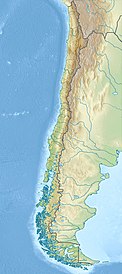Cerro Pachón is a mountain in central Chile,[2] located east of the city of La Serena in the Coquimbo Region. The mountain is seismically active.[3] It is the site of the 8.1 m Gemini South Telescope of the Gemini Observatory,[4] and the 4.1 m SOAR optical imager.[5] As of 2020, the Vera C. Rubin Observatory is being constructed at this site.[6]
| Cerro Pachón | |
|---|---|
 The SOuthern Astrophysical Research Telescope (SOAR) and Gemini South telecopes on Cerro Pachón as seen from Cerro Tololo in June of 2006. | |
| Highest point | |
| Elevation | 2,682 m (8,799 ft) |
| Coordinates | 30°14′16.41″S 70°44′01.11″W / 30.2378917°S 70.7336417°W[1] |
| Geography | |
 | |
| Country | Chile |
The mountain site has arid, desert conditions with cacti, shrubs, and wildflowers dotting the landscape. It is host to fauna that include Andean condor, viscachas, and the occasional fox, as well as typical desert species such as lizards, snakes, spiders, and scorpions.[7]
Observatories
editStarting in 1964, Cerro Morado and Cerro Pachón were the subject of routine observations of seeing conditions. Known as astronomical seeing monitors (ASM), these were operated by the Carnegie Institution of Washington.[8]
In 1989, site planning was begun by the National Optical Astronomy Observatory to select two sites for a proposed pair of 8 m telescopes, one in the northern hemisphere and the other in the south. The first telescope would be located on Mauna Kea in Hawaii, while the second would be at the Cerro Tololo Inter-American Observatory (CTIO), possibly on Cerro Pachón. It is the highest peak within the CTIO boundary, rising some 500 m higher than the nearby peaks of Cerro Tololo and Cerro Morado.[9] A site survey showed that the seeing conditions on Cerro Pachón rivalled that on Mauna Kea, and it was chosen as the site for the Gemini South observatory.[10] First light for the newly-commissioned telescope took place on January 18, 2002.[11]
The Andes Lidar Observatory was constructed on Cerro Pachón by the University of Illinois and saw first light in 2009.[12] This is an upper atmosphere facility that is supported by the National Science Foundation. It uses ground-based remote sensing instruments to study the atmosphere, particularly between altitudes of 80 to 110 km.[13]
Gallery
edit-
Wide view observatories from the air, including Cerro Pachón. In the distance are the Andes
-
Vera C. Rubin Observatory, showing the access road atop Cerro Pachón
See also
editReferences
edit- ^ "Travel Information Cerro Pachón - Chile". NOIRLab. Retrieved 2024-10-28.
- ^ Ridpath, Ian (19 January 2012). A Dictionary of Astronomy. OUP Oxford. ISBN 978-0-19-960905-5.
- ^ Neill, Douglas R. (September 2012). "Seismic analysis of the LSST telescope". Ground-based and Airborne Telescopes IV. Proceedings of the SPIE. 8444. id. 84440T. Bibcode:2012SPIE.8444E..0TN. doi:10.1117/12.926258.
- ^ Jamieson, Valerie (2002). "A new golden age for astronomy". Physics World. 15 (3): 23. doi:10.1088/2058-7058/15/3/29.
- ^ Schwarz, Hugo E.; et al. (September 2004). Moorwood, Alan F. M.; Masanori, Iye (eds.). "The SOAR optical imager: status and first results". Ground-based Instrumentation for Astronomy. Proceedings of the SPIE. 5492: 564–573. Bibcode:2004SPIE.5492..564S. doi:10.1117/12.553185.
- ^ Thomas, Sandrine J.; et al. (December 2020). "Vera C. Rubin Observatory: telescope and site status". Proceedings of the SPIE. 11445. id. 114450I. Bibcode:2020SPIE11445E..0IT. doi:10.1117/12.2561581.
- ^ "Cerro Pachón". rubinobservatory.org. Retrieved 2024-12-11.
- ^ Irwin, John B. (February 1966). "Variation of seeing with zenith distance". Astronomical Journal. 71: 28. Bibcode:1966AJ.....71...28I. doi:10.1086/109849.
- ^ Wong, Woon-Yin; Barr, Lawrence D. (March 1989). "The Planning of NOAO 8-M Telescope Enclosure and Facilities". Astrophysics and Space Science. 160 (1–2): 87–101. Bibcode:1989Ap&SS.160...87W. doi:10.1007/BF00642757.
- ^ Osmer, P. S. (October 1993). "The Gemini Project". Revista Mexicana de Astronomía y Astrofísica. 26: 83. Bibcode:1993RMxAA..26...83O.
- ^ "First light on Gemini South". Physics World. January 18, 2002. Retrieved 2024-10-28.
- ^ Swenson, G. R.; et al. (December 2009). The Andes Lidar Observatory (ALO) at Cerro Pachon, Chile, first light. American Geophysical Union, Fall Meeting 2009. id. SA53A-1252. Bibcode:2009AGUFMSA53A1252S.
- ^ "Andes Lidar Observatory". Retrieved 2024-11-06.
